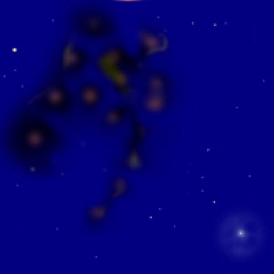This page will present a brief introduction to Young Stellar Objects and Star Formation. What it is and why we are so darn interested by the whole thing - and what we, as amateur astronomers, can do in helping to discover more about the amazing, violent processes that are going on, as you read this, in deepest space (at least that's what most of us are; apologies to you lucky visitors who actually get paid for doing astronomy)
That's the fact at the heart of Star Formation. As the Galaxy rotates (slowly, admittedly, but very surely) things happen. Stars approach and recede from their near neighbours. Clouds of gas and dust churn and are pulled in all directions by neighbouring stars, other gas clouds, or whatever. Massive stars explode as supernovae, sending mighty shock waves across lightyears of space. The sheer enormous gravity of the massed ranks of billions of stars (all moving of course!) ensures that those big bold words above ring true.
|
|
|
|
|
1. Gas/dust cloud minding its own business |
2. Nearby star becomes Supernova |
3. Shock wave compresses and energises areas of the cloud |
In the brief vignette above, note how those parts of the cloud facing the explosion are affected by the highly energetic radiation from the star. For most of its life this cloud has been sitting in space just a few degrees above absolute zero and then it is hit by this! The material that makes up the cloud is very thinly spread indeed, but there is a lot of it nevertheless. The radiation and shock not only warms the cloud but compresses it, so that the material begins to clump together into actual masses, thus acquiring noticeable gravitational attraction. These gas and dust clumps therefore tend to attract more of the surrounding material, thus becoming even more massive. This situation of positive feedback continues until we have areas of markedly more extreme mass. Eventually a lot of the cloud material will go into accumulating into the core regions, which are still cold, but getting warmer.
This is one way by which star formation can be triggered. But Supernovae are not exactly everyday events, and the formation process can also start under less violent circumstances; for instance, as a cloud rotates with the rest of the galaxy, it may come near a star or stars which can also initiate cloud collapse. And since most of the material in the Galaxy is to be found along the relatively thin galactic plane, that's where most star formation occurs too. Most YSO's are therefore found near the path of the Milky Way in constellations like Sagittarius, Orion and Cepheus.
|
|
|
|
|
4. Compressed areas start to form cores |
5. Cores accrete more material from cloud |
6. View of a single proto-stellar core |
Now see where the variations come from, in part 2







